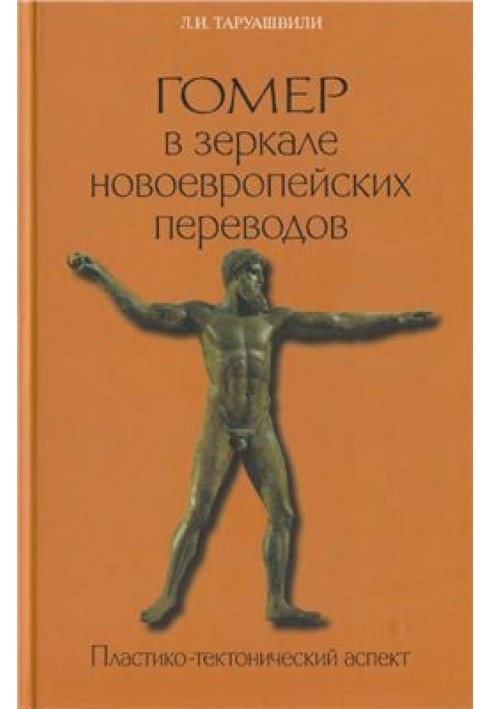Homer in the mirror of modern European translations. Plastic-tectonic aspect
 Instant download
Instant download
after payment (24/7)
 Wide range of formats
Wide range of formats
(for all gadgets)
 Full book
Full book
(including for Apple and Android)
Comparing the plastic images of the Olympic gods and architectural structures, as given by Homer, with their interpretation by modern European translators, the author of this research work shows the tendency towards dematerialization of these images, which characterizes to one degree or another everything (at least from the 15th to the middle . XIX century) new European translations of Homer's poems and carried out through the elimination of the effect of mechanical stability, and often through its displacement by the motif of flight and even free soaring. In this the author sees additional confirmation of the hypothesis about the deep spiritualistic and anti-classical predisposition of post-antique culture. For philologists, art critics and historians, as well as all readers who are interested in the question of the place and significance of antiquity in European cultural history. CONTENTS: PREFACE 5 INTRODUCTORY SECTION HOMER IN THE MAIN NEW EUROPEAN TRANSLATIONS (before 1850): CHRONOLOGY 11 HOMER IN THE NEW EUROPEAN TRANSLATIONS (before 1850): LIST OF CITED TRANSLATIONS OF THE “ILIADS” AND “ODYSSEY” 39 MAIN SECTION INTRODUCTION 45 TECTONICS OF THE DIVINE BODY 52 JOURNEY OF A DREAM 54 ATHENA IN THE ILIAD » 66The first journey. Goal: to keep Achilles from dealing with Agamemnon 67 Methodological retreat 72 Second journey. Goal: to keep the Achaeans from returning home prematurely 73The third journey. Goal: to prevent the conclusion of peace 78Fourth journey. Goal: to force Ares, who is helping the Trojans, to leave the battlefield 83Fifth Journey. Goal: stop the successful onslaught of the Trojans 86The sixth journey. Goal: strengthen the physical strength and spirit of Achilles, feeding him nectar and ambrosia instead of the usual food, which he rejects in mourning for Patroclus 88 The Seventh Journey. Goal: to participate in the battle between the gods who patronize and are hostile to the Trojans 90 The eighth (and final) journey. Goal: to deceive Hector to enter into battle with Achilles and thereby achieve the death of Hector 90 ATHENA IN THE ODYSSEY 94 The First Journey. Goal: to guide Telemachus in search of his father 94 The second journey. Goal: to help Telemachus make a long trip to inquire about the fate of his father 100Third Journey. Goal: to arrange for Nausicaä to accidentally discover Odysseus, washed ashore by a storm 102 The Fourth Journey. Goal: to help Odysseus get to the king of the Phaeacians Alcinous, so that then, with the assistance of the latter, he could get on a Phaeacian ship to his native Ithaca 106Fifth journey. Purpose: to give instructions to Odysseus, who arrived in Ithaca, in further actions. 108Sixth Journey. Goal: to encourage Telemachus to return from Lacedaemon to Ithaca 109 Seventh Journey: Goal: to provide conditions for the unrecognized penetration of Odysseus into his own home, among Penelope’s suitors 112 Eighth Journey. Goal: to dispel Odysseus’s worries and give him peaceful sleep 114The Ninth Journey. Goal: to help Odysseus, having destroyed the suitors and avoided the undesirable consequences of this act, to restore the status quo in his home and kingdom 118 Tenth and final journey. Goal: to reconcile Odysseus with his fellow citizens who raised weapons against him 120 ATHENA AND HERMES: high-speed shoes 123 Methodological introduction 123 Consideration 124 HERMES: returns to Olympus 132 APOLLO 136 APEC: feet as a mover 144 ZEUS 145 Preliminary conclusions 148 TECTONICS OF DIVINE BUILDING 150 THE OLYMPIC HOUSE AND ITS FOUNDATION 151 FLOOR IN THE OLYMPIC HOUSE 156 TECTONICS OF CONSTRUCTION IN THE WORLD OF PEOPLE 160 CONCLUSION 171
Data sheet
- Name of the Author
- Леонид Таруашвили Иосифович
- Language
- Russian












